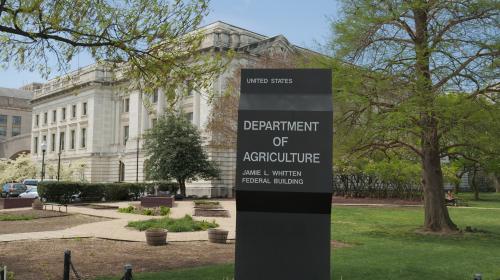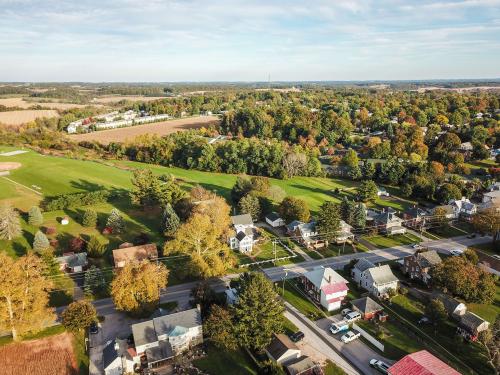This is the first in a two-part blog series on the evolution of rural policy in America reflected in recent federal legislative and executive actions. Part 2 on the proposed Rural Partnership Program is here.
Despite having carried the vote in only 10 percent of rural counties and 15 percent of rural counties that are in economic distress, President Biden has publicly made it a priority to rebuild rural America. For political observers, this may reflect political savvy—cutting losses in just a few rural counties will be key to statewide races, whether to win the electoral college, Senate seats, or state government offices—or tangible evidence that the president is serious about unifying the country. For policy wonks, it is a recognition that the fortunes of rural Americans are inextricably intertwined with key administration priorities, such as addressing climate change and the legacy of racism. Over 50 percent of rural Black residents and 45 percent of rural Native Americans live in economically distressed counties, persistent poverty counties are over 85 percent rural, and rural places will play a central role in transitioning to a clean energy economy.
The administration is intent on following through with policy and resources: Susan Rice, director of the Domestic Policy Council, has suggested that the American Rescue Plan, approved and signed into law on March 11, and the proposed American Jobs Plan, the administration’s basis for the current negotiations with Congress on infrastructure, will represent “historic levels of public investment” in rural America.
Grants to local governments: A step forward
Designed as both relief and stimulus, a significant portion of the already approved $1.9 trillion American Rescue Plan represents a one-time injection into the country’s social safety net programs. These include direct payments to families, unemployment benefits, child tax credits, and assistance for housing and health care. By definition, these programs do not offer special treatment to rural Americans, but the amount that will reach rural people will be significant. Some rural regions may ultimately benefit at higher rates because of disproportionate levels of poverty and unemployment.
At the community level, the $350 billion relief fund for states and local governments offers rural places a chance to mitigate the effects of the pandemic while laying the groundwork for future development efforts. Of the $65.1 billion set aside for counties, $15.33 billion—over 23 percent—will go to non-metropolitan counties.
Rural towns, municipalities, and townships will not fare as well out of the other $65.1 billion directly committed to city governments and local jurisdictions. While $19.5 billion is reserved for smaller jurisdictions—that is, non-county governments with a population less than 50,000—most of these will be within the boundary of a metropolitan area.
Nonetheless, the flexibility of these grants represents a step forward. Our recent analysis of federal assistance highlighted the void in this type of community investment for equitable rural development. This funding will allow local leaders the ability to make their own decisions within a set of broad parameters.
Many will seek to fill fiscal holes left by the pandemic and other economic transitions (as a group, rural areas still had not returned to pre-2008 levels of labor rate participation by the time the pandemic hit). The grants also offer an opportunity to enable locally-led strategies and get local solutions underway that could have a lasting effect. However, while the overall federal investment through this fund is substantial, the grants themselves are unlikely to be large enough to cover the types of cornerstone projects that local leaders have in mind. Many communities will also feel the need to strengthen their capacity with people, expertise, and more robust organizations to be successful with such efforts.
Increasing the return on investment for equitable rural development: A three-point plan
These dynamics highlight the importance of making sure that other resources within the administration’s legislative actions and proposals are friendly, or even intentionally designed, to meet the unique needs of rural communities, especially those in persistent poverty counties or experiencing significant economic distress. Improving the effectiveness of this federal aid and increasing its development “return on investment” will be important if these resources are to have lasting, meaningful consequences for rural communities over the long term.
Since quick action was a top priority when putting the American Rescue Plan together, it depends upon existing programs and mechanisms to funnel the resources. Not all programs have the discretion or flexibility to intentionally target and enable equitable rural development, but several—such as the $4 billion to support local food systems, the $1 billion to offer technical assistance and capacity building to socially disadvantaged farmers, and the over $7 billion for broadband access—have rural built in.
Another major opportunity lies in the $3 billion appropriated for the Economic Adjustment Assistance grants managed by the Economic Development Administration (EDA), which represents a ten-fold increase over EDA’s typical annual appropriation. This is EDA’s most flexible program, but it is unlikely to reach the rural communities that would benefit most without shaping its uses accordingly. The commitment of $10 billion of financing for the State Small Business Credit Initiative (SSBCI) could also be transformational, since small businesses make up about 90 percent of the businesses in rural areas.
Several key principles can enable the administration to maximize the impact of these resources and make good on the pledge to advance equitable rural prosperity:
1. Rural-conscious rulemaking: As we pointed out in our earlier analysis, rural areas are often faced with eligibility requirements, scoring criteria, or other program parameters that unintentionally result in a structural urbanism that disadvantages less densely populated places.
Making the resources in the American Rescue Plan meaningful for rural may mean making modifications. For EDA, for example, it would be helpful to reduce the typical 20 percent funding match required by recipients down to zero at certain levels of distress or size, especially since many rural areas—especially those in persistent poverty or with majority-minority communities—have limited access to other types of resources such as philanthropic funding. USDA can maximize its food systems funding by seeking to achieve multiple objectives, such as strengthening local food hubs and regional markets while increasing the supply of food assistance to those economically affected by COVID-19.
Greater flexibility will be important to address other critical issues such as housing and respond to other social concerns, like dealing with substance abuse within workforce training and development programs.
2. Strategic follow-on: While the American Rescue Plan represents significant investment overall, for many underserved rural places determined to strengthen their long-term resilience and remake their economies, it will simply be a start. Much can be done to optimize the outcomes through the specific resources made available by the American Rescue Plan; nonetheless, it will be crucial for the administration to recognize the importance of following it with further intentionality.
The proposals in the American Jobs Plan currently under discussion thus loom large. For example, it contains a suggestion to create the $5 billion Rural Partnership Program, which specifically seeks to meet rural communities where they are at and offer flexible support to build their capacity and consistency to successfully carry out locally-led strategies and solutions.
Other actions such as President Biden’s executive order on equity will also be important to maintain a focus on underserved communities. As part of its implementation, OMB recently issued a request for information for tools that can enable departments and offices to improve their effectiveness and reach by changing their program design and parameters.
3. Transparency: While it seems basic, merely updating data regularly about the financing flowing from the American Rescue Plan and making it public, easily accessible, and easily mapped geographically will be critical to understanding its effectiveness. For example, while EDA often states that 60 percent of its funding reaches rural areas, there is no easy way to verify this, nor identify which rural places it served and what effect it purportedly had. While approximately 15 percent of the original iteration of SSBCI landed in rural areas overall, differentiating among rural areas shows that the program struggled to reach places with fewer financing options, such as those in persistent poverty. Getting the program parameters right depends on having good data and responding to subsequent accountability nudges.
USASpending.gov, the website created by Treasury to meet the mandate of the Federal Funding Accountability and Transparency Act of 2006 (FFATA) and the Digital Accountability and Transparency Act of 2014 (DATA), has created a special COVID-19 site to follow the implementation of the CARES Act and the American Rescue Plan. While the site has a map for users to drill down to the county or Congressional district, the mapping function does not allow users to differentiate among programs. The map also does not distinguish between the CARES Act and American Rescue Plan funding, nor differentiate between rural and urban. It should be as easy for U.S. taxpayers to view this information for domestic programs as it is for them to view U.S. investments made internationally—especially since this money is being spent in their own backyard.
A key objective: Clarifying national rural policy
Ultimately, creating a national rural strategy would enhance the effectiveness of federal resources as they start to reach rural, enabling the kind of sustained attention that will be necessary to generate widespread progress in rural communities across the country. Establishing clear and coherent policy priorities for rural resilience, priorities unambiguously understood and taken seriously across the federal government, would increase the chances of success as federal resources are deployed. This is a major opportunity for the administration over the next four years, to pursue systemic reforms and improvements in how federal investments are made and outcomes achieved in rural America.
While still early, the administration is off to a good start, pursuing concrete actions that could translate into investments useful to everyday people and local efforts. Spending the political capital to stay on course will be critical in the coming months.







Commentary
Will Biden deliver for rural America? The promise of the American Rescue Plan
June 22, 2021